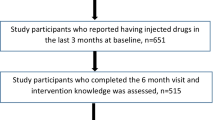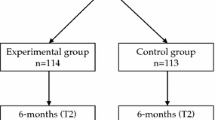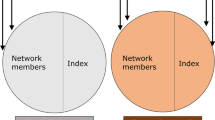Abstract
We developed and pilot-tested the Migrants’ Approached Self-Learning Intervention in HIV/AIDS for Tajiks (MASLIHAT). We recruited 30 Tajik labor migrants who inject drugs in Moscow as peer educators (PEs) to attend the 5-session intervention, then share what they learned with their peers. Each PE recruited two drug-injecting network members for interviewing about their drug and sexual behavior at baseline, 6 weeks, 3 months, and 6 months post-intervention. GEE and mixed effects regression tested time and participant type effects on each outcome. HIV knowledge and risk perception increased among both PEs and network peers, while use of shared syringes, condomless sex, sex with a sex worker, and alcohol use decreased significantly for both groups at 6 weeks and 3 months with a sustained effect through 6 months. The MASLIHAT intervention proved successful in disseminating HIV prevention information and reducing HIV risk behavior over 6 months among both PEs and network members.
Resumen
Desarrollamos y realizamos una prueba piloto de la Intervención de autoaprendizaje con enfoque de migrantes en el VIH / SIDA para tayikos (MASLIHAT). Reclutamos a 30 trabajadores migrantes tayikos que se inyectan drogas en Moscú como educadores de pares (EP) para asistir a la intervención de 5 sesiones y luego compartir lo que aprendieron con sus pares. Cada EP reclutó a dos miembros de la red de usuarios de drogas inyectables para entrevistarlos sobre su comportamiento sexual y con las drogas al inicio, 6 semanas, 3 meses y 6 meses después de la intervención. El GEE y la regresión de efectos mixtos probaron el tiempo y los efectos del tipo de participante en cada resultado. El conocimiento del VIH y la percepción del riesgo aumentaron tanto entre los EP como entre los compañeros de la red, mientras que el uso de jeringas compartidas, el sexo sin condón, el sexo con una trabajadora sexual y el consumo de alcohol disminuyeron significativamente para ambos grupos a las 6 semanas y 3 meses con un efecto sostenido durante 6 meses. La intervención MASLIHAT tuvo éxito en la difusión de información sobre la prevención del VIH y en la reducción de las conductas de riesgo del VIH durante 6 meses entre los EP y los miembros de la red.
Similar content being viewed by others
Data Availability
The datasets generated and analyzed during the current study are available in the Open Science Framework repository through permission from the authors.
References
UNAIDS. International Organization for Migration. Migration and AIDS. Int Migr. 1998;36(4):445–68.
Del Amo J, Bröring G, Hamers FF, Infuso A, Fenton K. Monitoring HIV/AIDS in Europe’s migrant communities and ethnic minorities. AIDS. 2004;18(14):1867–73.
El-Bassel N, Gilbert L, Shaw SA, et al. The Silk Road Health Project: how mobility and migration status influence HIV risks among male migrant workers in Central Asia. PLoS ONE. 2016;11(3):e0151278.
Weine SM, Kashuba AB. Labor migration and HIV risk: a systematic review of the literature. AIDS Behav. 2012;16(6):1605–21.
Olimova S, Bosc I. Labor migration from Tajikistan. Geneva: International Organization for Migration; 2003.
World Health Organization (WHO). Epidemiological Factsheet: Tajikistan: UNAIDS: Joint UN Programme on HIV/AIDS; 2010.
Bakhromov M, Levy JA. Double jeopardy through social marginalization: HIV risk among Tajik male labor migrants in Moscow. Drug Alcohol Depend. 2013;132(Supplement 1):S53–5.
Deren S, Shedlin M, Decena CU, Mino M. Research challenges to the study of HIV/AIDS among migrant and immigrant Hispanic populations in the United States. J Urban Health. 2005;82(3):13–25.
Needle R, Zhao L. HIV Prevention among Injection Drug Users: Strengthening U.S. Support for Core Interventions. Washington, DC: Center for Strategic & International Studies; 2010.
HIV/AIDS Prevention Research Synthesis Project. Compendium of Evidence-Based Interventions and Best Practices for HIV Prevention. Self-Help in Eliminating Life-Threatening Diseases (SHIELD): Centers for Disease Control and Prevention.
Hall A, Wellman B. Social networks and social support. In: Cohen S, Syme L, editors. Social support and health. New York: Academic Press; 1985. p. 23–41.
Yang X. Temporary migration and HIV risk behaviors in China. Environ Plan. 2006;38:1527–43.
Snipes SA, Cooper SP, Shipp EM. “The only thing I wish I could change is that they treat us like people and not like animals”: Injury and discrimination among Latino farmworkers. J Agromedicine. 2017;22(1):36–46.
Kosny A, Santos I, Reid A. Employment in a “land of opportunity?” Immigrants’ experiences of racism and discrimination in the Australian workplace. Int Migration Integr. 2017;18(2):483–97.
Md MR, Subramaniam T, Islam MR. Economic and social well-being of Asian labour migrants: A literature review. Soc Indic Res. 2019;141(3):1245–64.
Heywood AE, Lopez-Velez R. Reducing infectious disease inequities among migrants. J Travel Med. 2019;26:2.
Green O, Ayalon L. Violations of workers’ rights and exposure to work-related abuse of live-in migrant and live-out local home care workers - a preliminary study: Implications for health policy and practice. Isr J Health Policy Res. 2018;7(1):32.
Frost DM. Hostile and harmful: structural stigma and minority stress explain increased anxiety among migrants living in the United Kingdom after the Brexit referendum. J Consult Clin Psychol. 2020;88(1):75–81.
Bagong S, Rahma S, Sutinah MH. Bargaining the future: A descriptive study of the lives of the Indonesian illegal migrant workers. Int Migration Integr. 2020;21(1):185–204.
Cailhol J, Khan N. Chronic hepatitis and HIV risks amongst Pakistani migrant men in a French suburb and insights into health promotion interventions: the ANRS Musafir qualitative study. BMC Public Health. 2020;20(1):1393.
Latkin CA, Sherman S, Knowlton A. HIV prevention among drug users: outcome of a network-oriented peer outreach intervention. Health Psychol. 2003;22(4):332–9.
Valente TW. Network models of the diffusion of innovations. Cresskill, NJ: Hampton Press; 1995.
Valente TW, Davis RL. Accelerating the diffusion of innovations using opinion leaders. Ann Am Acad Pol Soc Sci. 1999;566(1):55–67.
Salter AB, Ryan P, Yelland LN. Performance of the modified Poisson regression approach for estimating relative risks from clustered prospective data. Am J Epidemiol. 2011;174(8):984–92.
Zou G. A modified Poisson regression approach to prospective studies with binary data. Am J Epidemiol. 2004;159(7):702–6.
Zou G, Donner A. Extension of the modified Poisson regression model to prospective studies with correlated binary data. Stat Methods Med Res. 2013;22(6):661–70.
Godinho J, Renton A, Vinogradov V, Novotny T, Rivers M-J. Reversing the Tide: Priorities for HIV/AIDS Prevention in Central Asia. World Bank Working Paper No. 54. Washington, DC: World Bank. https://openknowledge.worldbank.org/handle/10986/7354.
Acknowledgements
Research reported in this publication was supported by the National Institute on Drug Abuse of the National Institutes of Health (USA) under Award Number R21DA039068. The content is solely the responsibility of the authors and does not necessarily represent the official views of the National Institutes of Health. We thank the Tajik Diaspora Union for its assistance and also the study’s participants and members of the MASLIHAT staff for making this research possible. We thank the Tajik Diaspora Union for its assistance and also the study’s participants and members of the MASLIHAT staff for making this research possible.
Funding
Research reported in this publication was supported by the National Institute on Drug Abuse of the National Institutes of Health (USA) under Award Number R21DA039068. The content is solely the responsibility of the authors and does not necessarily represent the official views of the National Institutes of Health.
Author information
Authors and Affiliations
Contributions
JL, CL and MB contributed to the study conception and design. Material preparation and data collection were performed by MB and JJ. MM conducted the data analysis. The first draft of the manuscript was written by JL and MM and all authors commented on previous versions of the manuscript. All authors read and approved the final manuscript.
Corresponding author
Ethics declarations
Conflict of interest
The authors have no conflicts of interest to declare that are relevant to the content of this article.
Ethics Approval
The study protocol was approved the Institutional Review Boards of the University of Illinois at Chicago, the PRISMA Research Center, and the Russian Autonomous NGO Scientific and Educational Center "Most v budushee".
Consent to Participate
Informed consent was obtained from all individual participants included in the study.
Additional information
Publisher's Note
Springer Nature remains neutral with regard to jurisdictional claims in published maps and institutional affiliations.
Rights and permissions
About this article
Cite this article
Levy, J.A., Mackesy-Amiti, M.E., Bakhromov, M. et al. A Network-Based HIV Prevention Intervention for Tajik Migrant Workers Who Inject Drugs. AIDS Behav 26, 719–727 (2022). https://doi.org/10.1007/s10461-021-03431-5
Accepted:
Published:
Issue Date:
DOI: https://doi.org/10.1007/s10461-021-03431-5




